
|
Cold Hole Over Jupiter’s Pole
- Click the image above for a larger view
- Full-Res JPEG (650 x 300) (15.9 kB)
- Full-Res TIFF (650 x 300) (176.2 kB)
Caption:
Observations with two NASA telescopes show that Jupiter has an arctic polar vortex similar to a vortex over Earth's Antarctica that enables depletion of Earth's stratospheric ozone.
These composite images of Jupiter's north polar region from the Hubble Space Telescope (right) and the Infrared Telescope Facility (left) show a quasi-hexagonal shape that extends vertically from the stratosphere down into the top of the troposphere. A sharp temperature drop, compared to surrounding air masses, creates an eastward wind that tends to keep the polar atmosphere, including the stratospheric haze, isolated from the rest of the atmosphere.
The linear striations in the composite projections are artifacts of the image processing. The area closest to the pole has been omitted because it was too close to the edge of the planet in the original images to represent the planet reliably.
The composite on the right combines images from the Wide Field and Planetary Camera 2 of the Hubble Space Telescope taken at a wavelength of 890 nanometers, which shows stratospheric haze particles.
The sharp boundary and wave-like structure of the haze layer suggest a polar vortex and a similarity to Earth's stratospheric polar clouds. Images of Jupiter's thermal radiation clinch that identification. The composite on the left, for example, is made from images taken with Jet Propulsion Laboratory's Mid-Infrared Large-Well Imager at NASA's Infrared Telescope Facility at a wavelength of 17 microns. It shows polar air mass that is 5 to 6 degrees Celsius (9 to 10 degrees Fahrenheit) colder than its surroundings, with the same border as the stratospheric haze. Similar observations at other infrared wavelengths show the cold air mass extends at least as high as the middle stratosphere down to the top of the troposphere.
These images were taken Aug. 11 through Aug. 13, 1999, near a time when Jupiter's north pole was most visible from Earth. Other Infrared Telescope Facility images at frequencies sensitive to the polar haze were taken at frequent intervals from June to October 1999. They show that the quasi-hexagonal structure rotates slowly eastward at 1.2 degrees of longitude per day, a rate consistent with the average wind speeds measured from movement of visible clouds.
Scientists studying the Earth's atmosphere are interested in these results because Jupiter's atmosphere provides a natural laboratory in which models of the polar vortex phenomenon can be studied under different conditions - for example, without the interference of topography. Of particular interest but yet unknown is how deep into Jupiter's troposphere the phenomenon extends. The answer to this question might be supplied by instrumentation on a polar orbiter mission at Jupiter.
Background Info:
These images were taken as part of a program to support NASA's Galileo spacecraft reconnaissance of Jupiter. The Infrared Telescope Facility is on the summit of Hawaii's Mauna Kea and is operated by the University of Hawaii under a cooperative agreement with NASA. The Hubble Space Telescope is a project of international cooperation between NASA and the European Space Agency. The telescope is managed by the Space Telescope Science Institute, Baltimore, which is operated by the Association of Universities for Research in Astronomy, Inc., for NASA, under contract with the Goddard Space Flight Center, Greenbelt, Md. The California Institute of Technology, Pasadena manages JPL for NASA.
Cataloging Keywords:
| Name | Value | Additional Values |
|---|---|---|
| Target | Jupiter | |
| System | Jupiter | |
| Target Type | Planet | |
| Mission | Galileo | Hubble Space Telescope (HST), Infrared Telescope Facility (IRTF) |
| Instrument Host | Hubble Space Telescope | Galileo Orbiter |
| Host Type | Space Telescope | Orbiter |
| Instrument | Wide Field/Planetary Camera 2 (WFPC2) | |
| Detector | ||
| Extra Keywords | Atmosphere, Color, Haze, Infrared, Rotation, Thermal | |
| Acquisition Date | ||
| Release Date | 2002-10-08 | |
| Date in Caption | 1999-08-13 | |
| Image Credit | NASA/JPL/HST/University of Hawaii | |
| Source | photojournal.jpl.nasa.gov/catalog/PIA03864 | |
| Identifier | PIA03864 | |
